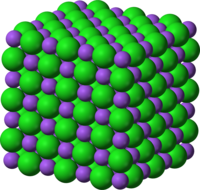
Photo from wikipedia
Abstract In this paper, a novel anisotropic Voronoi algorithm is presented, along with its implementation and two application cases. In contrast to standard Voronoi tessellations, the proposed algorithm takes into… Click to show full abstract
Abstract In this paper, a novel anisotropic Voronoi algorithm is presented, along with its implementation and two application cases. In contrast to standard Voronoi tessellations, the proposed algorithm takes into account preferred growth directions, aspect ratios and areas of individual grains. Therefore, an elliptical growth field, which is defined on a per grain basis, is adopted which specifies the time a single grain seed point needs to grow to a specific point in the domain of interest. Grains can be extracted in a grain-conforming or non-grain-conforming manner. The latter case is applicable to simulations in which a predetermined mesh is used, e.g. voxel-mesh based simulations. The extraction can then be done in a straightforward manner. For the former case, a more elaborate extraction algorithm is presented. Finally, the characteristics of the resulting microstructural geometries of two application cases (wire + arc additively manufactured and cast metal microstructure) are studied. A pronounced correspondence with the experimental grain morphology is obtained. This algorithm is highly versatile for generating polycrystalline (metal) microstructures, especially since it closely mimics the underlying solidification process. However, it is more generally applicable to generate an anisotropic tessellation with spatially varying preferential growth directions.
Journal Title: Computational Materials Science
Year Published: 2021
Link to full text (if available)
Share on Social Media: Sign Up to like & get
recommendations!